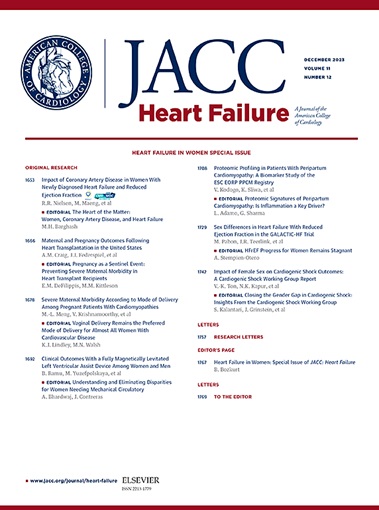利用基于深度学习的自然语言处理技术自动识别射血分数降低的心力衰竭。
IF 11.8
1区 医学
Q1 CARDIAC & CARDIOVASCULAR SYSTEMS
引用次数: 0
摘要
背景:由于缺乏衡量医疗质量的自动化工具,限制了射血分数减低型心力衰竭指导性医疗评估国家计划的实施:由于缺乏衡量护理质量的自动化工具,限制了射血分数减低型心力衰竭(HFrEF)指导性护理评估国家计划的实施:作者旨在自动识别出院时的射血分数降低型心力衰竭(HFrEF)患者,为评估和改善护理质量提供机会:作者开发了一种新型深度学习语言模型,用于从耶鲁纽黑文医院 2015 年至 2019 年期间的心衰住院患者出院摘要中识别 HFrEF 患者。HFrEF根据左心室射血分数定义 结果:模型开发共使用了来自 5392 名独特个体(年龄 73 ± 14 岁,48% 为女性)的 13251 份记录,其中包括 2487 名 HFrEF 患者(46.1%)(训练/暂停:70%/30%)。该模型在检测保留组中的 HFrEF 时,接收者工作特征曲线下面积 (AUROC) 为 0.97,精确召回曲线下面积 (AUPRC) 为 0.97。该模型在识别 HFrEF 方面表现出色,在西北医学中心的 19,242 份病历中,AUROC = 0.94,AUPRC = 0.91;在耶鲁大学社区医院的 139 份人工摘录病历中,AUROC = 0.95,AUPRC = 0.96;在 MIMIC-III 的 146 份人工审核病历中,AUROC = 0.91,AUPRC = 0.92。与诊断代码相比,基于模型的 HFrEF 预测净重分类率提高了 60.2 ± 1.9%(P < 0.001):作者开发了一种语言模型,能从临床笔记中高精度、高准确性地识别出 HFrEF,是实现 HFrEF 患者质量评估自动化的关键因素。本文章由计算机程序翻译,如有差异,请以英文原文为准。
Automated Identification of Heart Failure With Reduced Ejection Fraction Using Deep Learning-Based Natural Language Processing
Background
The lack of automated tools for measuring care quality limits the implementation of a national program to assess guideline-directed care in heart failure with reduced ejection fraction (HFrEF).
Objectives
The authors aimed to automate the identification of patients with HFrEF at hospital discharge, an opportunity to evaluate and improve the quality of care.
Methods
The authors developed a novel deep-learning language model for identifying patients with HFrEF from discharge summaries of hospitalizations with heart failure at Yale New Haven Hospital during 2015 to 2019. HFrEF was defined by left ventricular ejection fraction <40% on antecedent echocardiography. The authors externally validated the model at Northwestern Medicine, community hospitals of Yale, and the MIMIC-III (Medical Information Mart for Intensive Care III) database.
Results
A total of 13,251 notes from 5,392 unique individuals (age 73 ± 14 years, 48% women), including 2,487 patients with HFrEF (46.1%), were used for model development (train/held-out: 70%/30%). The model achieved an area under receiver-operating characteristic curve (AUROC) of 0.97 and area under precision recall curve (AUPRC) of 0.97 in detecting HFrEF on the held-out set. The model had high performance in identifying HFrEF with AUROC = 0.94 and AUPRC = 0.91 on 19,242 notes from Northwestern Medicine, AUROC = 0.95 and AUPRC = 0.96 on 139 manually abstracted notes from Yale community hospitals, and AUROC = 0.91 and AUPRC = 0.92 on 146 manually reviewed notes from MIMIC-III. Model-based predictions of HFrEF corresponded to a net reclassification improvement of 60.2% ± 1.9% compared with diagnosis codes (P < 0.001).
Conclusions
The authors developed a language model that identifies HFrEF from clinical notes with high precision and accuracy, representing a key element in automating quality assessment for individuals with HFrEF.
求助全文
通过发布文献求助,成功后即可免费获取论文全文。
去求助
来源期刊

JACC. Heart failure
CARDIAC & CARDIOVASCULAR SYSTEMS-
CiteScore
21.20
自引率
2.30%
发文量
164
期刊介绍:
JACC: Heart Failure publishes crucial findings on the pathophysiology, diagnosis, treatment, and care of heart failure patients. The goal is to enhance understanding through timely scientific communication on disease, clinical trials, outcomes, and therapeutic advances. The Journal fosters interdisciplinary connections with neuroscience, pulmonary medicine, nephrology, electrophysiology, and surgery related to heart failure. It also covers articles on pharmacogenetics, biomarkers, and metabolomics.
 求助内容:
求助内容: 应助结果提醒方式:
应助结果提醒方式:


